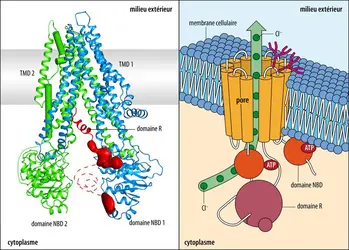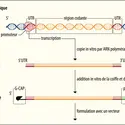MUCOVISCIDOSE ou FIBROSE KYSTIQUE DU PANCRÉAS
- 1. Présentation clinique de la mucoviscidose
- 2. Épidémiologie de la mucoviscidose
- 3. Le gène et la protéine CFTR
- 4. Les relations génotype CFTR/phénotype clinique
- 5. Histoire et géographie des mutations du gène CFTR
- 6. Diagnostic précoce de la mucoviscidose
- 7. Les traitements de la mucoviscidose : la révolution des thérapies « mutations spécifiques »
- 8. Bibliographie
- 9. Sites internet
Bibliographie
M. D. Amaral, « Novel personalized therapies for cystic fibrosis: treating the basic defect in all patients », in Journal of InternalMedicine, vol. 277, n° 2, pp. 155-166, 2015 (https://doi.org/10.1111/joim.12314)
D. H. Andersen, « Cystic fibrosis of the pancreas and its relation to celiac disease: A clinical and pathologic study », in American Journal of Diseases of Children, vol. 56, n° 2, pp. 344-399, 1938 (https://doi.org/10.1001/archpedi.1938.01980140114013)
C. Bombieri, M. Claustres, K. De Boeck et al., « Recommendations for the classification of diseases as CFTR-related disorders », in Journal of CysticFibrosis, vol. 10, suppl. 2, S86-102, 2011 (https://doi.org/10.1016/S1569-1993(11)60014-3)
P. R. Burgel, G. Bellis, H. V. Olesen et al., « Future trends in cystic fibrosis demography in 34 European countries », in EuropeanRespiratory Journal, vol. 46, n° 1, pp. 133-141, 2015 (https://doi.org/10.1183/09031936.00196314)
P. R. Burgel, I. Durieu, R. Chiron et al. pour le French CysticFibrosis Reference Network Study Group, « Rapid improvement after starting elexacaftor-tezacaftor-ivacaftor in patients with cystic fibrosis and advanced pulmonary disease », in American Journal of Respiratory and Critical Care Medicine, vol. 204, n° 1, pp. 64-73, 2021 https://doi.org/10.1164/rccm.202011-4153OC
M. Chillón, T. Casals, B. Mercier et al., « Mutations in the cystic fibrosis gene in patients with congenital absence of the vas deferens », in New England Journal of Medicine, vol. 332, n° 22, pp. 1475-1480, 1995 https://doi.org/10.1056/NEJM199506013322204
J. A. Cohn, K. J. Friedman, P. G. Noone et al., « Relation between mutations of the cystic fibrosis gene and idiopathic pancreatitis », in New England Journal of Medicine, vol. 339, n° 10, pp. 653-658, 1998 (https://doi.org/10.1056/NEJM199809033391002)
F. S. Collins, « Cystic fibrosis: molecular biology and therapeutic implications », in Science, vol. 256, n° 5058, pp. 774-779, 1992
Cystic Fibrosis Genotype-Phenotype Consortium, « Correlation between genotype and phenotype in patients with cystic fibrosis », in The New England Journal of Medicine, vol. 329, n° 18, pp. 1308-1313, 1993 (htpps://doi.org/ 10.1056/NEJM199310283291804)
P. Di Sant'Agnese, R. C. Darling, G. A. Perera & E. Shea, « Abnormal electrolyte composition of sweat in cystic fibrosis of the pancreas; clinical significance and relationship to the disease », in Pediatrics, vol. 12, n° 5, pp. 549-563, 1953
V. Dumur, R. Gervais, J.-M. Rigot et al., « Abnormal distribution of CF ΔF508 allele in azoospermic men with congenital aplasia of epididymis and vas deferens », in The Lancet, vol. 336, n° 8713, p. 512. 1990
G. Fanconi, E. Uehlinger & C. Knauer, « Das Coeliakiesyndrom bei Angeborener zysticher Pankreasfibromatose und Bronchiektasien », in Wiener MedizinischeWochensschrift, vol. 86, pp. 753-756, 1936
P. Farrell, C. Férec & M. Macek, « Estimating the age of (p.Phe508del) with family studies of geographically distinct European populations and the early spread of cystic fibrosis », in European Journal of Human Genetics, vol. 26, n° 12, pp. 1832-1839, 2018 (https://doi.org/10.1038/s41431-018-0234-z)
P. M. Farrell, M. R. Kosorok, A. Laxova et al. pour le Wisconsin Cystic Fibrosis Neonatal Screening Study Group, « Nutritional benefits of neonatal screening for cystic fibrosis » in The New England Journal of Medicine, vol. 337, n° 14, pp. 963-969, 1997 (https://doi.org/10.1056/NEJM199710023371403)
C. Férec, M.-P. Audrezet, B. Mercier et al., « Detection of over 98% cystic fibrosis mutations in a Celtic population », in Nature Genetics, vol. 1, n° 3, pp. 188-191, 1992
C. Férec & G. R. Cutting, « Assessing the disease-liability of mutations in CFTR », in Cold Spring Harbor Perspectives in Medicine, vol. 2, n° 12, 2012 (https://doi.org/10.1101/cshperspect.a009480)[...]
- 1. Présentation clinique de la mucoviscidose
- 2. Épidémiologie de la mucoviscidose
- 3. Le gène et la protéine CFTR
- 4. Les relations génotype CFTR/phénotype clinique
- 5. Histoire et géographie des mutations du gène CFTR
- 6. Diagnostic précoce de la mucoviscidose
- 7. Les traitements de la mucoviscidose : la révolution des thérapies « mutations spécifiques »
- 8. Bibliographie
- 9. Sites internet
La suite de cet article est accessible aux abonnés
- Des contenus variés, complets et fiables
- Accessible sur tous les écrans
- Pas de publicité
Déjà abonné ? Se connecter
Écrit par
- Claude FÉREC : professeur des Universités, praticien hospitalier (PU/PH), professeur émérite de génétique médicale, université de Brest
Classification
Pour citer cet article
Claude FÉREC. MUCOVISCIDOSE ou FIBROSE KYSTIQUE DU PANCRÉAS [en ligne]. In Encyclopædia Universalis. Disponible sur : (consulté le )
Médias
Autres références
-
ARNm THÉRAPEUTIQUES
- Écrit par Bruno PITARD
- 6 616 mots
- 5 médias
Les thérapies de remplacement sont en essai clinique pour le traitement de la mucoviscidose. Les patients atteints de mucoviscidose souffrent d’infections pulmonaires répétées et de problèmes respiratoires chroniques dus au défaut de la protéine CFTR (cysticfibrosistransmembrane conductance... -
HÉRÉDITÉ
- Écrit par Charles BABINET, Luisa DANDOLO, Jean GAYON, Simone GILGENKRANTZ
- 11 231 mots
- 7 médias
...risque sur 4 d'avoir, à chaque nouvelle naissance, un enfant atteint. Les enfants indemnes de la fratrie ont une probabilité de 2/3 d'être hétérozygotes. Un bon exemple en est la mucoviscidose (ou fibrose kystique du pancréas), maladie récessive la plus fréquente dans les populations européennes. Cette maladie... -
MALADIES MOLÉCULAIRES
- Écrit par Jean-Claude DREYFUS, Fanny SCHAPIRA
- 6 786 mots
- 1 média
Un modèle de maladie autosomique récessive, la mucoviscidose (ou fibrose kystique). C'est la plus fréquente des maladies récessives en Europe, touchant un enfant pour 2 500 naissances, ce qui signifie que la fréquence des porteurs sains hétérozygotes est de 1 sur 25. Elle entraîne deux symptômes... -
MYCOBACTÉRIES
- Écrit par Carlo COCITO, Universalis, Gabriel GACHELIN
- 4 331 mots
- 5 médias
...mycobactérioses aggravant des affections pulmonaires chroniques (silicose par ex.) est sérieux. Mais il est encore plus à craindre pour les patients atteints de mucoviscidose : Mycobacterium avium est ici le plus souvent en cause. Le traitement se fonde sur la sensibilité des souches à la clarithromycine, et... - Afficher les 7 références
Voir aussi
- MUCUS
- TRYPSINE
- POUMON
- HÉRÉDITAIRES MALADIES ou MALADIES GÉNÉTIQUES
- STÉATORRHÉE
- GÉNOTYPE
- SUEUR
- NÉONATOLOGIE
- INFECTION
- ENFANT MALADIES DE L'
- VECTEUR, thérapie génique
- PROTÉINES MEMBRANAIRES
- KINÉSITHÉRAPIE
- HÉRÉDITÉ AUTOSOMIQUE RÉCESSIVE
- PNEUMOLOGIE
- BRONCHE
- INSUFFISANCE RESPIRATOIRE
- THÉRAPIE GÉNIQUE
- CIRRHOSE
- RESPIRATOIRE PATHOLOGIE
- HÉTÉROZYGOTE
- BRONCHITE
- DIAGNOSTIC PRÉNATAL
- ANTÉNATOLOGIE
- DÉPISTAGE, médecine
- TRITHÉRAPIE






